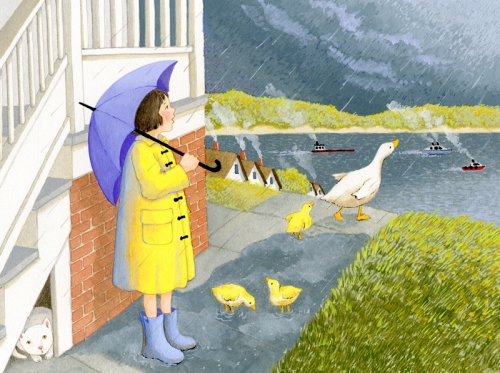
Here is illustrator Joanne Friar’s painting of a rainy day done in acrylic gouache on HP watercolor paper and based on a poem from Robert Louis Stevenson’s “A Child’s Garden of Verses”. Joanne was featured on March 10th on Illustrator Saturday. You can use this link to see the whole post: http://wp.me/pss2W-4j3
Thought you would be interested in an interesting article written by Jeremy Greenfield for Forbes the other day, titled, How the Authors Guild Is Kind of Like the NRA and Why Scott Turow Is Wrong About Authors which rebutted an op-ed for the New York Times, written by Authors Guild president Scott Turow (who is also a lawyer and the best-selling author of legal thrillers like The Burden of Proof and Presumed Innocent). In this weeks article Turow, lamented that authors are under siege in the ebook era.
Turow’s angst all came about when last month, the Supreme Court decided to allow the importation and resale of foreign editions of American works, which are often cheaper than domestic editions. Until now, courts have forbidden such activity as a violation of copyright. Not only does this ruling open the gates to a surge in cheap imports, but since they will be sold in a secondary market, authors won’t get royalties.
Jeremy Greenfeld pointed out in his Forbes article that the vast majority of authors in the U.S. are not best-selling authors. Many of them have greatly benefited from the massive changes that have swept across the literary landscape in the U.S. Before the rise of ebooks, only a small fraction of them would have been able to live out their lifelong dream of becoming a published author. Now tens of thousands of them do it every month.
Below are a few excerpts from Jeremy’s article. The full article is worth reading, since you will not get the comparison of the NRA and the Authors Guild if you don’t read Jeremy’s whole piece.
(According to a recent survey of nearly 5,000 authors by Digital Book World — that Jeremy Greenfield authored — the top three reasons authors want to publish books are:
To build their careers as writers;
To satisfy a lifelong ambition; and
To write something that people are willing to buy.
To make money is fourth. The full study is available here.)
Some small percentage of those dreamers (an incredibly small percentage) go on to become Hugh Howey and Amanda Hocking. So, to the many of you out there who enjoyed Wool or My Blood Approves, thank some of the changes in book publishing.
The system that vaulted a talented (and lucky) few to the top is still thriving. Publishers are making just as much if not more money than ever before and the mega best-seller is alive and well. Check out the ebook best-seller list every week and you’ll see that big publishers dominate. Time and again, they are able to market and sell titles that spend months on the list. Want to sell millions of copies of a book? The same path that has always existed is probably your best bet.
But what if you’re not that talented (or lucky)? What if you don’t know the right people or nobody sees in your work what you see in it? Well, self publishing is now a viable option and a legitimate path to big sales numbers.
For some authors, the new publishing paradigm now offers them a choice between established publishers and publishing their own work themselves.
There are authors, such as narrative non-fiction and picture book writers, who are having trouble finding footing in the new era — and some of them write the most vital literature we have. Take Robert Caro, the author of several valuable and critically acclaimed tomes on Lyndon B. Johnson. Each of his books takes years to complete and probably can’t be done any other way. That kind of work takes investment and an appetite for risk; in the future, we may see fewer investments on Caro-like work. That would be a tragedy for American letters.
At this year’s Writer’s Digest conference in New York, there were nearly 500 attendees, enthusiastic writers who are interested in working on their craft and learning the business of publishing (disclosure: Writer’s Digest is a sister company to Digital Book World, my employer.) From what I heard, writers at the conference echoed the sentiment that now is the best time ever to be a writer.
“The vibe at the conference was incredibly upbeat,” Writer’s Digest community leader Phil Sexton told me. “Regardless of what challenges exist, most writers that we spoke to seemed to agree that we have far more publishing options and opportunities than we did even a few years ago.”
While there are things that the Authors Guild should oppose in defense of its constituents’ interests, it should not be done on a platform of “authors under attack” because that’s clearly not the case for the vast majority of authors. For most, this is the best time in history to be an author.
Talk tomorrow,
Kathy
Thanks for bringing these extremely valuable pieces to us, Kathy 🙂
LikeLike
By: :Donna Marie on April 11, 2013
at 12:31 am
Donna,
Thought it was an interesting article. So many ways to look at the issue.
Kathy
LikeLike
By: Kathy Temean on April 17, 2013
at 3:59 pm